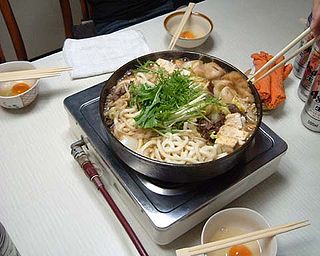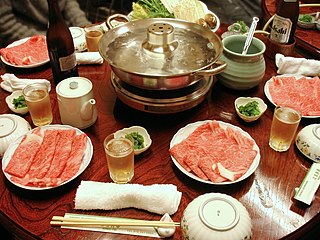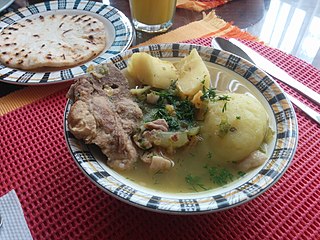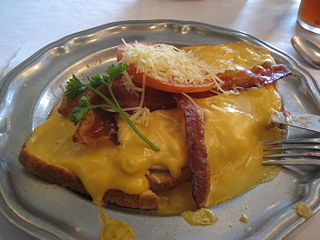
Nabemono, or simply nabe, is a variety of Japanese hot pot dishes, also known as one pot dishes and "things in a pot".

Goulash is a soup or stew of meat and vegetables seasoned with paprika and other spices. Originating in Hungary, goulash is a common meal predominantly eaten in Central Europe but also in other parts of Europe. It is one of the national dishes of Hungary and a symbol of the country.

Polish cuisine is a style of food preparation originating in and widely popular in Poland. Due to Poland's history, Polish cuisine has evolved over the centuries to be very eclectic, and shares many similarities with other national cuisines. Polish cooking in other cultures is often referred to as à la polonaise.

Russian cuisine is a collection of the different dishes and cooking traditions of the Russian people as well as a list of culinary products popular in Russia, with most names being known since pre-Soviet times, coming from all kinds of social circles.

Shabu-shabu is a Japanese nabemono hotpot dish of thinly sliced meat and vegetables boiled in water and served with dipping sauces. The term is onomatopoeic, derived from the sound – "swish swish" – emitted when the ingredients are stirred in the cooking pot. The food is cooked piece by piece by the diner at the table. Shabu-shabu is generally more savory and less sweet than sukiyaki, another hot pot dish.

A ham hock or pork knuckle is the joint between the tibia/fibula and the metatarsals of the foot of a pig, where the foot was attached to the hog's leg. It is the portion of the leg that is neither part of the ham proper nor the ankle or foot (trotter), but rather the extreme shank end of the leg bone.

Peasant foods are dishes eaten by peasants, made from accessible and inexpensive ingredients.

Sancocho is a traditional stew in Canarian cuisine and several Latin American cuisines. Latin variations represent popular national dishes in Dominican Republic, Colombia, Cuba, Honduras, Mexico, Ecuador, Panama, Puerto Rico, Trinidad and Tobago, and Venezuela. It usually consists of large pieces of meat, tubers and vegetables served in a broth.

Kare-kare is a Philippine stew that features a thick savory peanut sauce. It is generally made from a base of stewed oxtail, beef tripe, pork hocks, calves' feet, pig's feet or trotters, various cuts of pork, beef stew meat, and occasionally offal. Vegetables, such as eggplant, Chinese cabbage, or other greens, daikon, green beans, okra, and asparagus beans, are added. The stew is flavored with ground roasted peanuts or peanut butter, onions, and garlic. It is colored with annatto and can be thickened with toasted or plain ground rice. Variations of kare-kare can be made with seafood, such as prawns, squid, and mussels, or exclusively from vegetables.

In South Africa, a potjiekos, literally translated "small-pot food", is a dish prepared outdoors. It is traditionally cooked in a round, cast iron, three-legged cauldron, the potjie, descended from the Dutch oven brought from the Netherlands to South Africa in the 17th century and found in the homes and villages of people throughout southern Africa. The pot is heated using small amounts of wood or charcoal or, if fuel is scarce, twisted grass or even dried animal dung.

The cuisine of Kentucky mostly resembles and is a part of traditional Southern cuisine. Some common dinner dishes are fried catfish and hushpuppies, fried chicken and country fried steak. These are usually served with vegetables such as green beans, greens, pinto beans slow-cooked with pork as seasoning and served with cornbread. Other popular items include fried green tomatoes, cheese grits, corn pudding, fried okra, and chicken and dumplings, which can be found across the commonwealth.

Czech cuisine has both influenced and been influenced by the cuisines of surrounding countries and nations. Many of the cakes and pastries that are popular in Central Europe originated within the Czech lands. Contemporary Czech cuisine is more meat-based than in previous periods; the current abundance of farmable meat has enriched its presence in regional cuisine. Traditionally, meat has been reserved for once-weekly consumption, typically on weekends.

Peranakan cuisine or Nyonya cuisine comes from the Peranakans, descendants of early Chinese migrants who settled in Penang, Malacca, Singapore and Indonesia, inter-marrying with local Malays. In Baba Malay, a female Peranakan is known as a nonya, and a male Peranakan is known as a baba. The cuisine combines Chinese, Malay, Javanese, South Indian, and other influences.

Soups in East Asian culture are eaten as one of the many main dishes in a meal or in some cases served straight with little adornment, particular attention is paid to the soups' stocks. In the case of some soups, the stock ingredients become part of the soup. They are usually based solely on broths and lacking in dairy products such as milk or cream. If thickened, the thickening usually consists of refined starches from corn or sweet potatoes.

Pottage or potage is a term for a thick soup or stew made by boiling vegetables, grains, and, if available, meat or fish. It was a staple food for many centuries. The word pottage comes from the same Old French root as potage, which is a dish of more recent origin.

A stew is a combination of solid food ingredients that have been cooked in liquid and served in the resultant gravy. Ingredients can include any combination of vegetables and may include meat, especially tougher meats suitable for slow-cooking, such as beef, pork, venison, rabbit, lamb, poultry, sausages, and seafood. While water can be used as the stew-cooking liquid, stock is also common. A small amount of red wine or other alcohol is sometimes added for flavour. Seasonings and flavourings may also be added. Stews are typically cooked at a relatively low temperature, allowing flavours to mingle.

Indonesian noodles are a significant aspect of Indonesian cuisine which is itself very diverse. Indonesian cuisine recognizes many types of noodles, with each region of the country often developing its own distinct recipes.

















